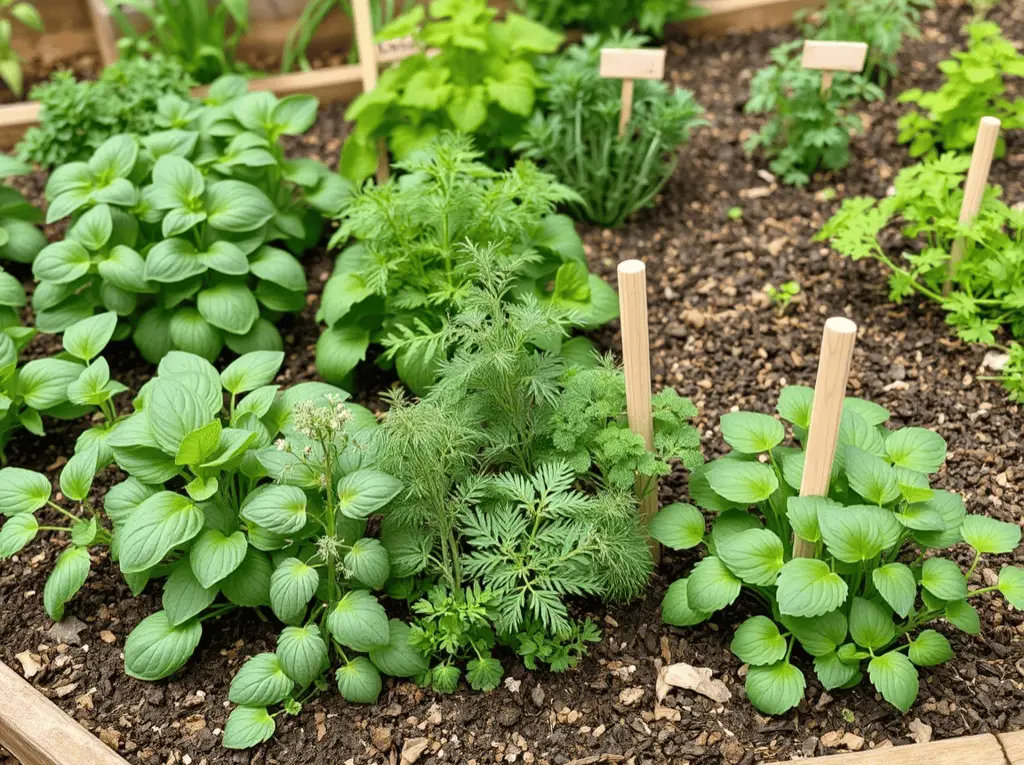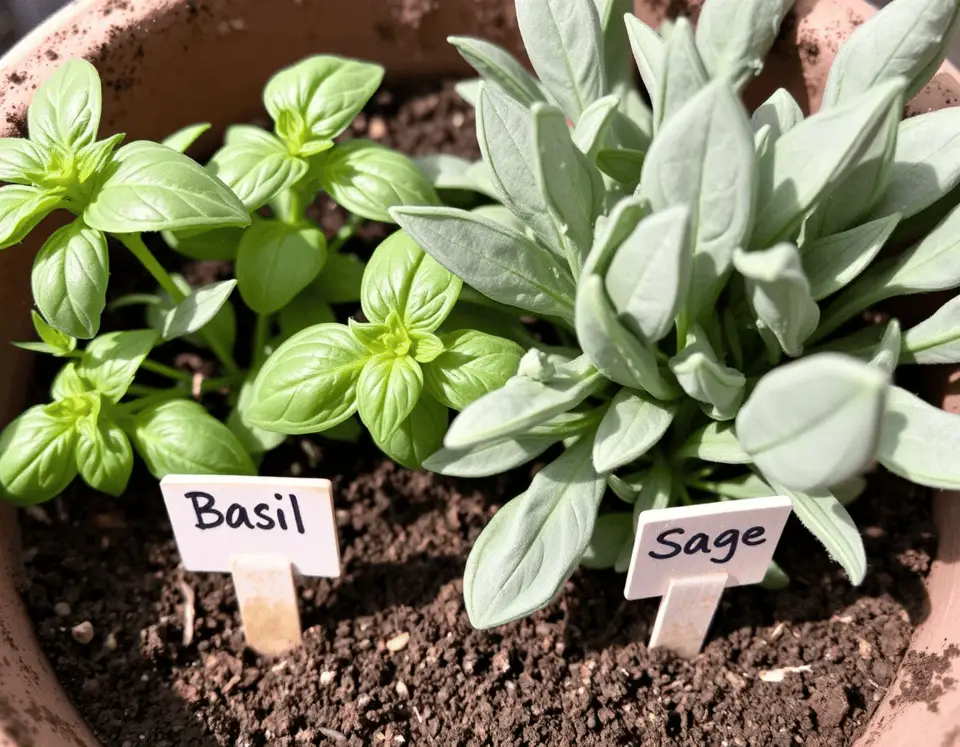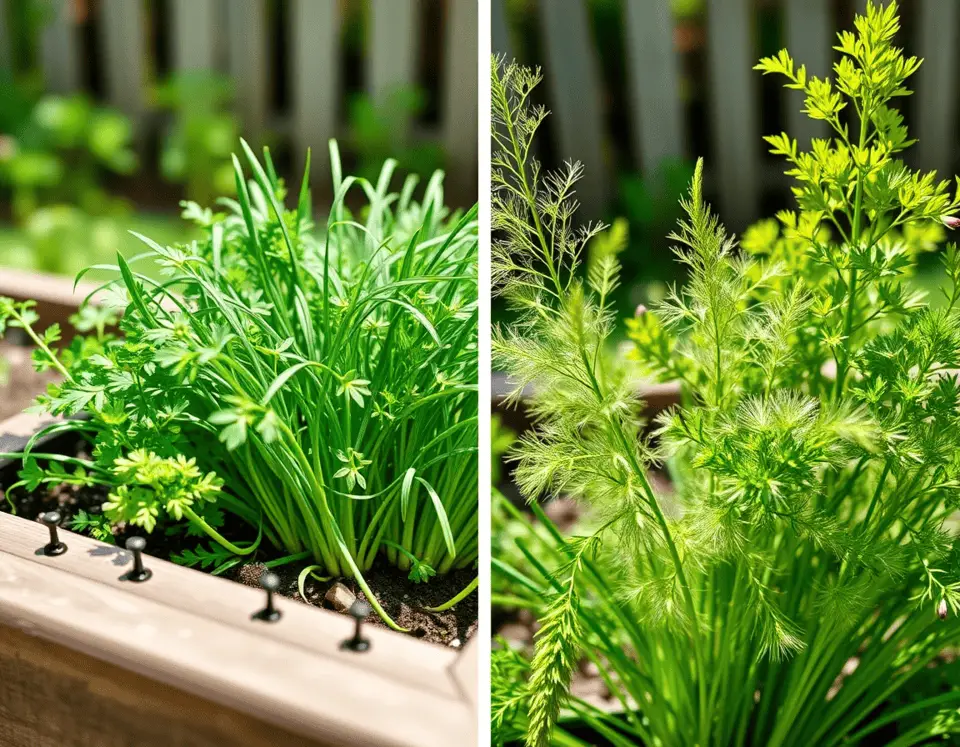Herbs That Don’t Grow Well Together: What to Avoid!
Not all herbs play nice in the garden. While some thrive side by side, others can stunt each other’s growth or even cause one to fail completely. In this post, we’ll look at herbs that don’t grow well together, and a few combinations that might surprise you. The good news? Once you know what to avoid, keeping your herb garden healthy gets a whole lot easier.
Table of Contents
- 1 Why Companion Planting Matters for Herbs
- 2 Top Herb Combinations to Avoid
- 3 Other Notorious Herb Pairings to Avoid
- 4 Summary Table: Herbs That Don’t Grow Well Together
- 5 Expert Tips for a Healthy Herb Garden
- 6 Frequently Asked Questions
- 7 Can I plant herbs with vegetables?
- 8 Why do some herbs inhibit others?
- 9 Is it safe to grow all herbs together in a single bed?
- 10 Conclusion
- 11 Author
Why Companion Planting Matters for Herbs
Companion planting is a time-honored gardening technique that involves strategically placing plants together based on how they interact. While some herbs can boost each other’s growth, repel pests, or enhance flavors, others can have the opposite effect, leading to stunted plants, reduced yields, or even the spread of disease.
The roots, leaves, and even the scents of certain herbs can impact their neighbors in ways that aren’t always obvious. By understanding these relationships, you can prevent common gardening pitfalls, create a more resilient ecosystem, and enjoy a garden that thrives with minimal intervention.
Top Herb Combinations to Avoid
1. Mint and Any Other Herb
- Why It Fails: Mint is notorious for its aggressive growth habits, quickly sending out runners that can take over entire garden beds. Its vigorous roots compete fiercely for water and nutrients, often choking out less robust herbs. Additionally, mint’s potent aroma can interfere with the delicate flavors of neighboring plants, making it difficult to cultivate a diverse herb garden in the same space.
- Best Practice: To keep mint’s rampant growth in check, always plant it in its own container or a segregated area of the garden. This not only protects your other herbs but also makes it easier to manage and harvest mint without worrying about it spreading uncontrollably.
2. Dill and Lavender, Marjoram, Sage, or Parsley
- Why It Fails: Dill thrives in moist, nutrient-rich soil, while herbs like lavender, marjoram, and sage prefer drier, well-drained conditions. Planting dill with these Mediterranean herbs creates a conflict in soil and watering needs, resulting in poor performance for both. Additionally, dill and parsley are closely related and can compete for the same resources, leading to stunted growth and diminished yields.
- Best Practice: To ensure optimal growth, keep dill separate from these incompatible herbs. Instead, pair dill with others that share its preference for moisture, such as basil or cilantro. This way, each plant receives the care it needs without compromising the health of its neighbors.
3. Sage and Chives
- Why It Fails: Sage and chives may seem like a natural pairing, but their growing requirements are fundamentally different. Sage thrives in dry, slightly alkaline soil and prefers infrequent watering, while chives need richer, moister conditions to flourish. When planted together, neither herb receives the ideal environment, leading to weak, unproductive plants.
- Best Practice: For best results, group sage with other drought-tolerant Mediterranean herbs like rosemary and thyme. Chives, on the other hand, should be planted with herbs that enjoy similar moisture levels, such as parsley or tarragon. This approach ensures that each herb can reach its full potential.
4. Fennel and Any Other Herb
- Why It Fails: Fennel is a unique herb that produces allelopathic chemicals, substances that inhibit the growth of nearby plants. These chemicals can stunt or even kill neighboring herbs and vegetables, making fennel a poor companion for almost any plant. Its tall, bushy growth habit can also overshadow smaller herbs, depriving them of sunlight.
- Best Practice: To avoid harming your other herbs, plant fennel in complete isolation, either in a dedicated garden bed or a large container. This not only prevents chemical interference but also makes it easier to control fennel’s growth and harvest its flavorful seeds and fronds.
5. Basil and Sage
- Why It Fails: Basil and sage have vastly different environmental needs. Basil thrives in moist, nutrient-rich soil and requires regular watering, while sage prefers drier, well-drained conditions and can suffer if overwatered. Planting them together often results in one or both herbs struggling to survive, with compromised flavor and reduced yields.
- Best Practice: To maximize growth and flavor, pair basil with other moisture-loving herbs like parsley, cilantro, or chervil. Sage, meanwhile, should be grouped with drought-tolerant companions such as rosemary, oregano, and thyme. This ensures each herb receives the conditions it needs to thrive.
Other Notorious Herb Pairings to Avoid
Anise and Coriander
- Conflict: Anise’s strong, licorice-like scent can easily overpower the subtle, citrusy flavor of coriander. Additionally, these herbs compete for the same space, water, and nutrients, which can result in both plants underperforming. This competition can also lead to cross-contamination of flavors, making it difficult to achieve the pure taste profiles that make each herb special.
- Solution: For the best results, plant anise with other robust, aromatic herbs that can hold their own, and pair coriander with milder companions like parsley or cilantro. This separation helps preserve the unique qualities of each herb and prevents unwanted flavor blending.
Basil and Rue
- Conflict: Rue releases volatile oils that can negatively impact the growth and flavor of basil. These oils may make basil taste bitter and can also deter pollinators, which are essential for basil’s healthy development. The proximity of rue can therefore reduce both the quality and quantity of your basil harvest.
- Solution: To avoid these issues, keep basil and rue well apart in your garden. Basil pairs well with herbs like oregano and thyme, while rue is better suited to growing alongside rosemary or lavender, where its strong scent can help repel pests without interfering with more delicate herbs.
Dill and Other Umbelliferae (Fennel, Caraway, Anise, Cumin, Carrots, Coriander)
- Conflict: Members of the Umbelliferae family are prone to cross-pollination, which can result in hybrid plants with muddled or undesirable flavors. Additionally, these herbs often compete for the same resources, leading to reduced vigor and lower yields across the board.
- Solution: To maintain the distinct flavors and characteristics of each herb, plant them in separate areas of your garden. This not only prevents unwanted cross-pollination but also allows you to tailor soil and watering conditions to each herb’s specific needs.
Different Varieties of Mint
- Conflict: Planting multiple mint varieties together may seem convenient, but it often leads to cross-flavoring, where the unique taste of each variety becomes diluted. The aggressive growth of mint also means that one variety can quickly dominate, crowding out the others and reducing your overall harvest.
- Solution: To preserve the distinct flavors of each mint variety, grow them in separate containers, spaced well apart. This approach makes it easier to manage their growth and ensures that each type retains its unique aroma and taste.
Summary Table: Herbs That Don’t Grow Well Together
| Herb 1 | Herb 2 (Avoid Planting Together) | Reason for Incompatibility |
|---|---|---|
| Mint | Any other herb | Invasive, overtakes space and nutrients |
| Dill | Lavender, Marjoram, Sage, Parsley | Different soil/moisture needs, competition |
| Sage | Chives | Incompatible soil/moisture requirements |
| Fennel | Any other herb | Releases growth-inhibiting chemicals |
| Basil | Sage, Rue | Different soil needs, flavor interference |
| Anise | Coriander | Scent/flavor conflict, competition |
| Dill | Fennel, Anise, Caraway, etc. | Cross-pollination, flavor loss |
| Mint (various) | Other mint varieties | Cross-flavoring, loss of unique taste |
This table is a quick reference to help you avoid common pitfalls when planning your herb garden. By keeping these incompatible pairings in mind, you can design a layout that supports robust growth and vibrant flavors.
Expert Tips for a Healthy Herb Garden
- Understand Each Herb’s Needs: Take the time to research the specific sunlight, soil, and water preferences of each herb before planting. This foundational knowledge will help you create microclimates within your garden that cater to the unique requirements of every plant.
- Use Containers: For aggressive or invasive herbs like mint and fennel, containers are a gardener’s best friend. They prevent these plants from spreading uncontrollably and make it easier to manage their growth while protecting other herbs from competition.
- Rotate and Separate: Changing the placement of your herbs each season helps prevent soil depletion and reduces the risk of disease buildup. Separating incompatible herbs also makes it easier to monitor their health and make adjustments as needed.
- Observe and Adjust: Regularly check on your herbs for signs of stress, disease, or poor growth. Be prepared to move or replant herbs if they’re not thriving in their current location. Flexibility and observation are key to maintaining a vibrant, productive garden.
Frequently Asked Questions
Can I plant herbs with vegetables?
Absolutely, but it’s important to be selective about which herbs you pair with vegetables. Some herbs, like basil, can help repel pests and enhance the growth of certain vegetables, while others, such as sage, may inhibit the growth of crops like cucumbers. Always research specific pairings to ensure compatibility and maximize the benefits of companion planting.
Why do some herbs inhibit others?
Herbs may inhibit each other’s growth for a variety of reasons, including competition for nutrients and water, differing environmental needs, or the release of allelopathic chemicals that suppress neighboring plants. Understanding these dynamics allows you to create a garden layout that minimizes conflict and promotes healthy, vigorous growth for all your herbs.
Is it safe to grow all herbs together in a single bed?
While it may be tempting to plant all your herbs in one bed for convenience, this approach often leads to problems. Different herbs have unique requirements and some can negatively affect others if grown too closely. Grouping herbs with similar needs and avoiding known incompatible pairings will help ensure a thriving, diverse herb garden.
Conclusion
Thoughtful companion planting is the cornerstone of a successful herb garden. By learning which herbs are incompatible and understanding the reasons behind these conflicts, you can design a space where every plant flourishes. Avoiding problematic pairings and grouping herbs by their needs not only enhances growth and flavor but also reduces the need for constant intervention. With a little planning and attention, you’ll enjoy a garden that’s both beautiful and bountiful, providing fresh, aromatic herbs for your kitchen all season long.
Ready to transform your herb garden? Explore more of our expert guides for inspiration, tips, and step-by-step instructions to help you grow your healthiest, most productive garden yet!









